Alcopops Tax and Social Impact
VerifiedAdded on 2020/05/28
|9
|1406
|129
AI Summary
The assignment examines the use of higher tax rates on alcopops to mitigate negative externalities imposed on society. It discusses how this policy aims to decrease youth purchasing power, influence marginal social benefits, and ultimately reduce alcohol-related harm. The analysis includes a diagram illustrating the impact of taxation on supply and demand, emphasizing the burden on consumers. Additionally, the assignment proposes information dissemination and education programs alongside taxation as effective strategies to combat binge drinking.
Contribute Materials
Your contribution can guide someone’s learning journey. Share your
documents today.
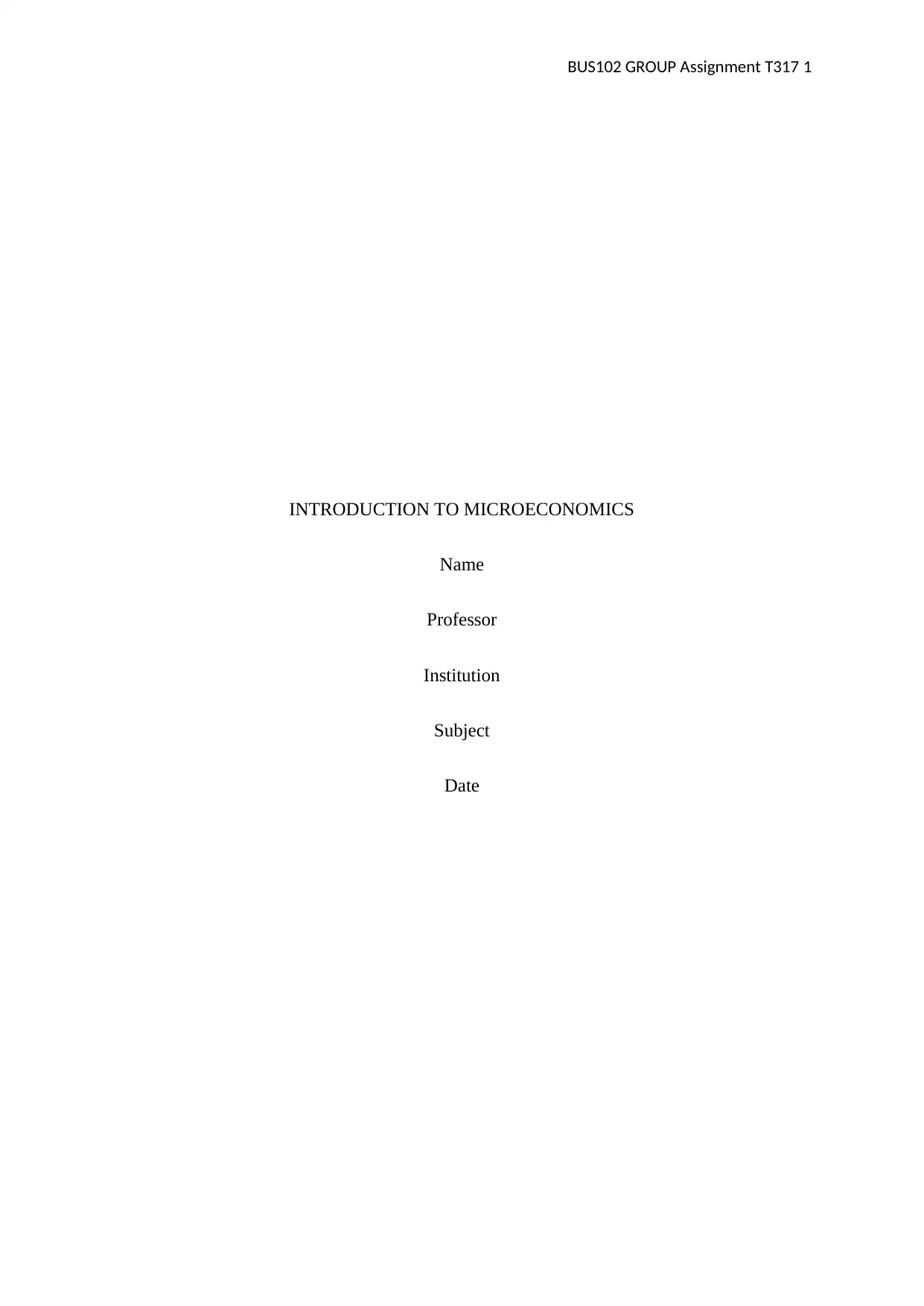
BUS102 GROUP Assignment T317 1
INTRODUCTION TO MICROECONOMICS
Name
Professor
Institution
Subject
Date
INTRODUCTION TO MICROECONOMICS
Name
Professor
Institution
Subject
Date
Secure Best Marks with AI Grader
Need help grading? Try our AI Grader for instant feedback on your assignments.
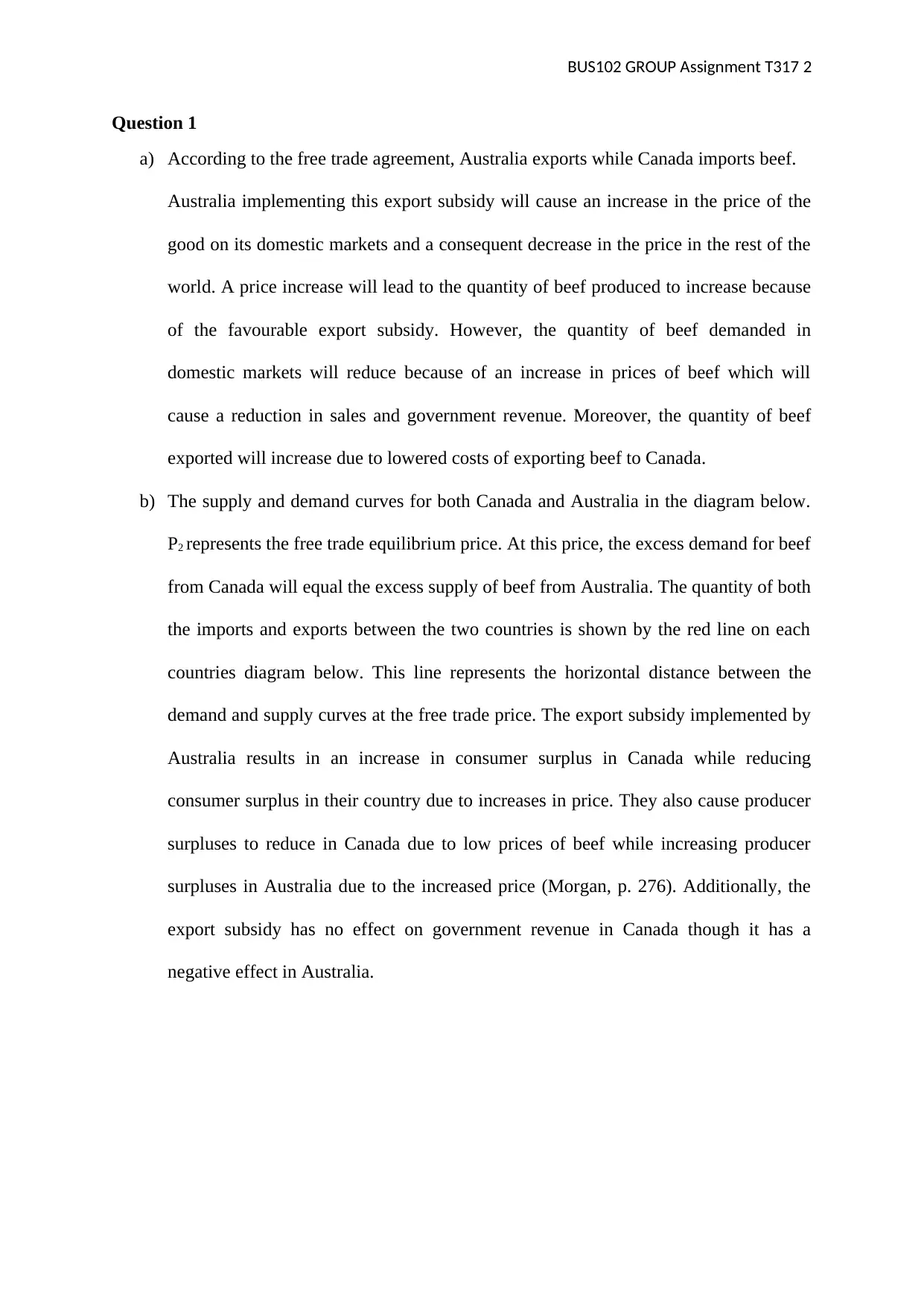
BUS102 GROUP Assignment T317 2
Question 1
a) According to the free trade agreement, Australia exports while Canada imports beef.
Australia implementing this export subsidy will cause an increase in the price of the
good on its domestic markets and a consequent decrease in the price in the rest of the
world. A price increase will lead to the quantity of beef produced to increase because
of the favourable export subsidy. However, the quantity of beef demanded in
domestic markets will reduce because of an increase in prices of beef which will
cause a reduction in sales and government revenue. Moreover, the quantity of beef
exported will increase due to lowered costs of exporting beef to Canada.
b) The supply and demand curves for both Canada and Australia in the diagram below.
P2 represents the free trade equilibrium price. At this price, the excess demand for beef
from Canada will equal the excess supply of beef from Australia. The quantity of both
the imports and exports between the two countries is shown by the red line on each
countries diagram below. This line represents the horizontal distance between the
demand and supply curves at the free trade price. The export subsidy implemented by
Australia results in an increase in consumer surplus in Canada while reducing
consumer surplus in their country due to increases in price. They also cause producer
surpluses to reduce in Canada due to low prices of beef while increasing producer
surpluses in Australia due to the increased price (Morgan, p. 276). Additionally, the
export subsidy has no effect on government revenue in Canada though it has a
negative effect in Australia.
Question 1
a) According to the free trade agreement, Australia exports while Canada imports beef.
Australia implementing this export subsidy will cause an increase in the price of the
good on its domestic markets and a consequent decrease in the price in the rest of the
world. A price increase will lead to the quantity of beef produced to increase because
of the favourable export subsidy. However, the quantity of beef demanded in
domestic markets will reduce because of an increase in prices of beef which will
cause a reduction in sales and government revenue. Moreover, the quantity of beef
exported will increase due to lowered costs of exporting beef to Canada.
b) The supply and demand curves for both Canada and Australia in the diagram below.
P2 represents the free trade equilibrium price. At this price, the excess demand for beef
from Canada will equal the excess supply of beef from Australia. The quantity of both
the imports and exports between the two countries is shown by the red line on each
countries diagram below. This line represents the horizontal distance between the
demand and supply curves at the free trade price. The export subsidy implemented by
Australia results in an increase in consumer surplus in Canada while reducing
consumer surplus in their country due to increases in price. They also cause producer
surpluses to reduce in Canada due to low prices of beef while increasing producer
surpluses in Australia due to the increased price (Morgan, p. 276). Additionally, the
export subsidy has no effect on government revenue in Canada though it has a
negative effect in Australia.
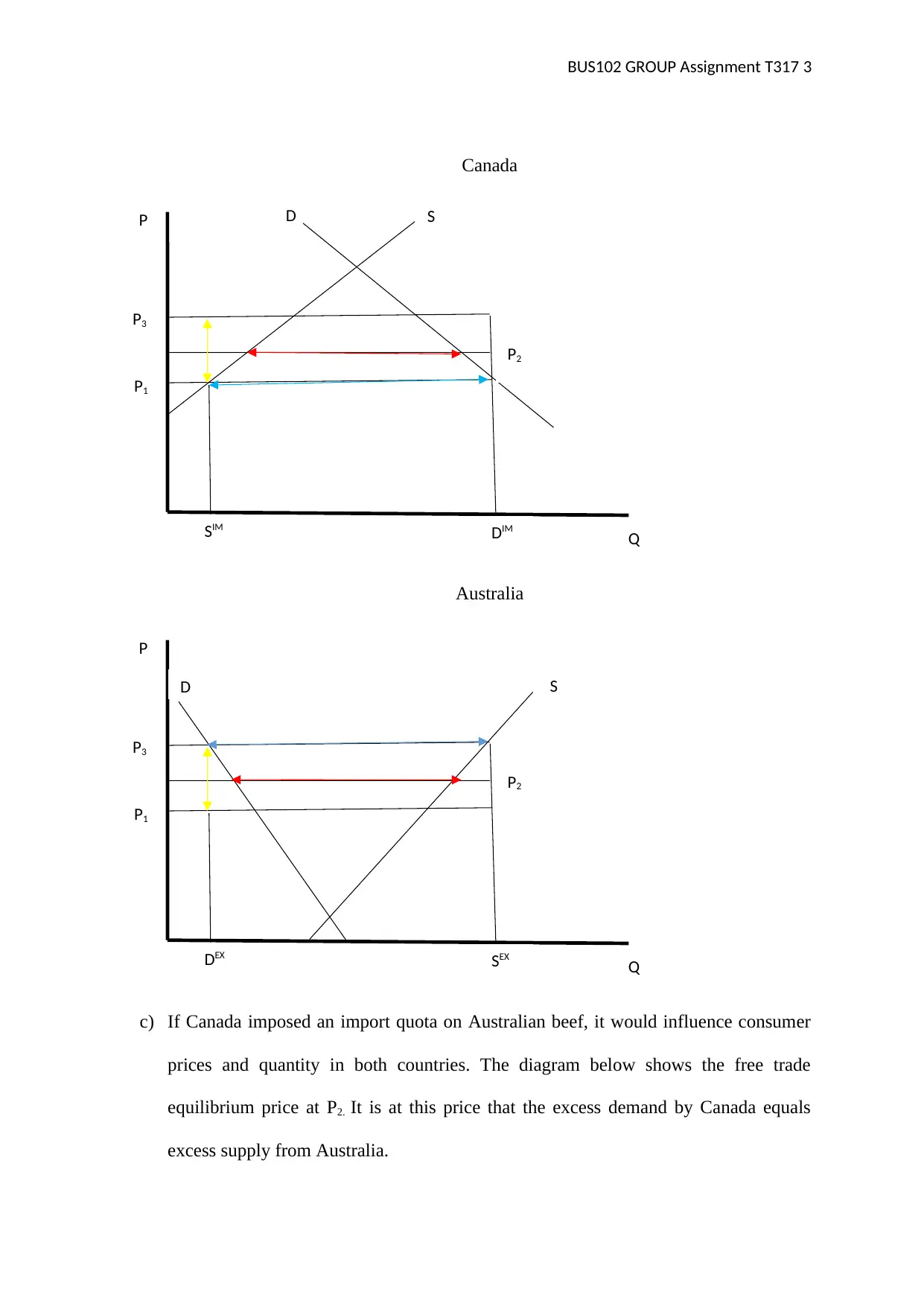
BUS102 GROUP Assignment T317 3
Canada
Australia
c) If Canada imposed an import quota on Australian beef, it would influence consumer
prices and quantity in both countries. The diagram below shows the free trade
equilibrium price at P2. It is at this price that the excess demand by Canada equals
excess supply from Australia.
P
P3
P2
P1
D S
SIM DIM
Q
P
P3
P2
P1
D S
DEX SEX
Q
Canada
Australia
c) If Canada imposed an import quota on Australian beef, it would influence consumer
prices and quantity in both countries. The diagram below shows the free trade
equilibrium price at P2. It is at this price that the excess demand by Canada equals
excess supply from Australia.
P
P3
P2
P1
D S
SIM DIM
Q
P
P3
P2
P1
D S
DEX SEX
Q
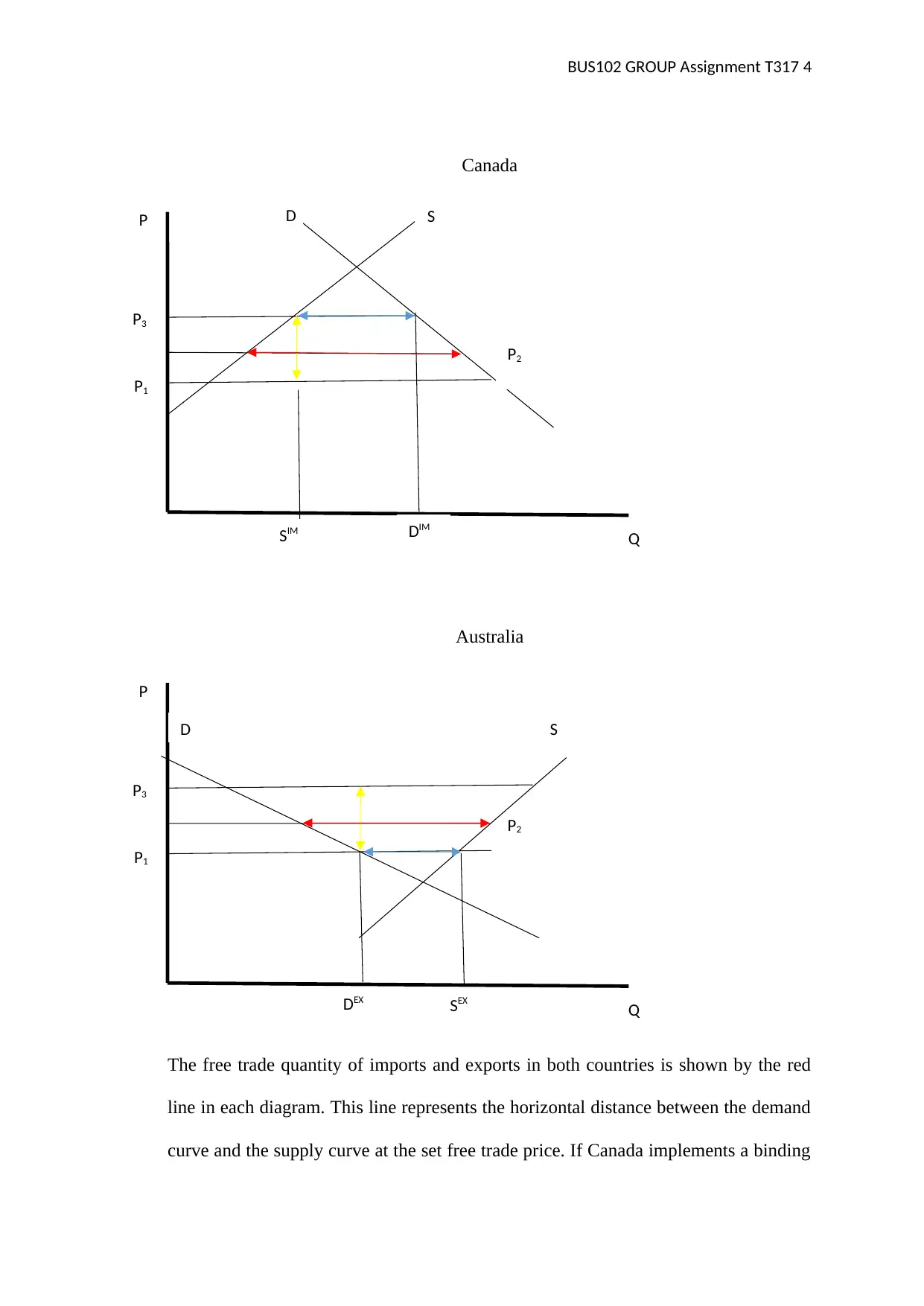
BUS102 GROUP Assignment T317 4
Canada
Australia
The free trade quantity of imports and exports in both countries is shown by the red
line in each diagram. This line represents the horizontal distance between the demand
curve and the supply curve at the set free trade price. If Canada implements a binding
P
P3
P2
P1
D S
DEX SEX
Q
P
P3
P2
P1
D S
SIM DIM
Q
Canada
Australia
The free trade quantity of imports and exports in both countries is shown by the red
line in each diagram. This line represents the horizontal distance between the demand
curve and the supply curve at the set free trade price. If Canada implements a binding
P
P3
P2
P1
D S
DEX SEX
Q
P
P3
P2
P1
D S
SIM DIM
Q
Secure Best Marks with AI Grader
Need help grading? Try our AI Grader for instant feedback on your assignments.
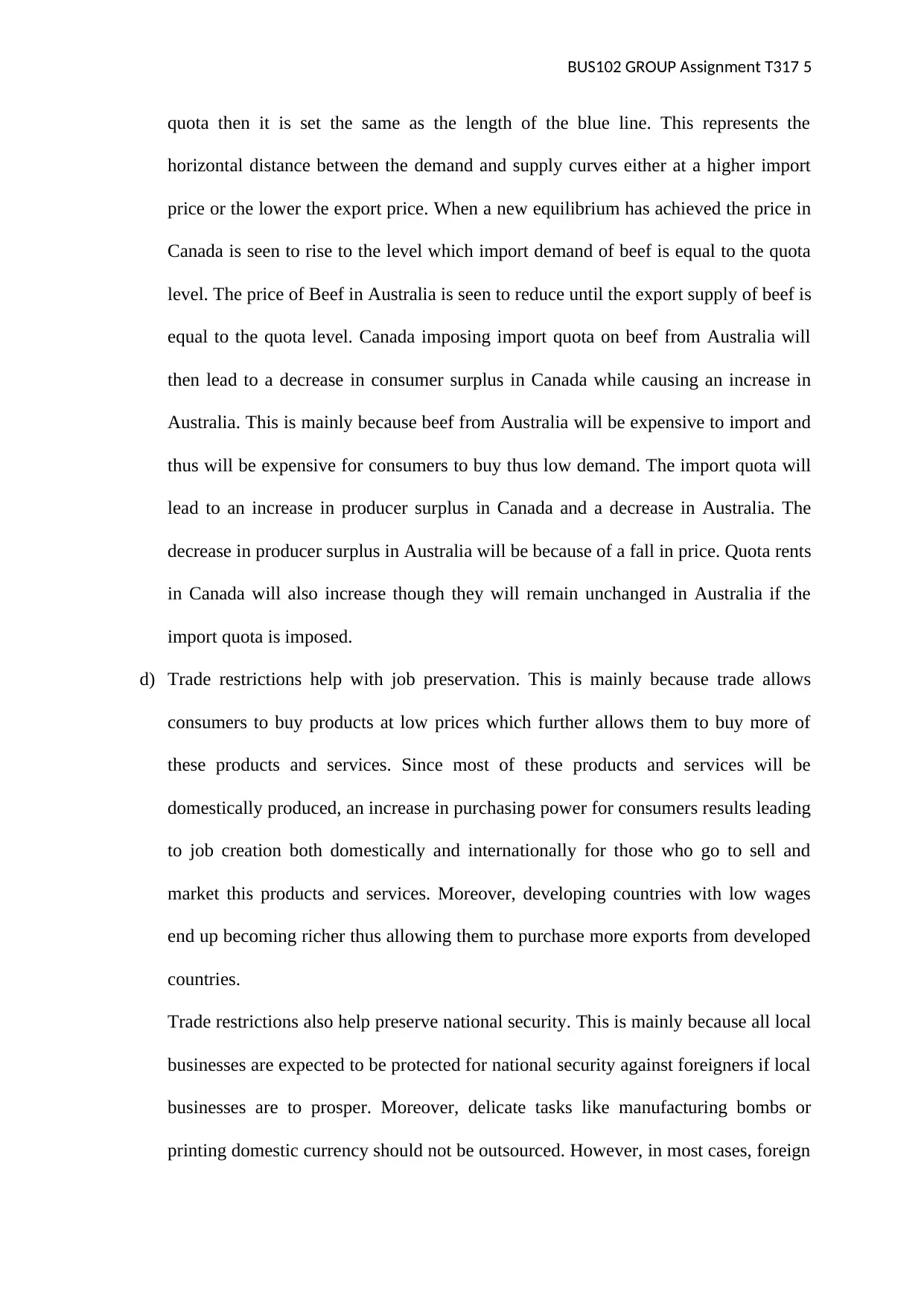
BUS102 GROUP Assignment T317 5
quota then it is set the same as the length of the blue line. This represents the
horizontal distance between the demand and supply curves either at a higher import
price or the lower the export price. When a new equilibrium has achieved the price in
Canada is seen to rise to the level which import demand of beef is equal to the quota
level. The price of Beef in Australia is seen to reduce until the export supply of beef is
equal to the quota level. Canada imposing import quota on beef from Australia will
then lead to a decrease in consumer surplus in Canada while causing an increase in
Australia. This is mainly because beef from Australia will be expensive to import and
thus will be expensive for consumers to buy thus low demand. The import quota will
lead to an increase in producer surplus in Canada and a decrease in Australia. The
decrease in producer surplus in Australia will be because of a fall in price. Quota rents
in Canada will also increase though they will remain unchanged in Australia if the
import quota is imposed.
d) Trade restrictions help with job preservation. This is mainly because trade allows
consumers to buy products at low prices which further allows them to buy more of
these products and services. Since most of these products and services will be
domestically produced, an increase in purchasing power for consumers results leading
to job creation both domestically and internationally for those who go to sell and
market this products and services. Moreover, developing countries with low wages
end up becoming richer thus allowing them to purchase more exports from developed
countries.
Trade restrictions also help preserve national security. This is mainly because all local
businesses are expected to be protected for national security against foreigners if local
businesses are to prosper. Moreover, delicate tasks like manufacturing bombs or
printing domestic currency should not be outsourced. However, in most cases, foreign
quota then it is set the same as the length of the blue line. This represents the
horizontal distance between the demand and supply curves either at a higher import
price or the lower the export price. When a new equilibrium has achieved the price in
Canada is seen to rise to the level which import demand of beef is equal to the quota
level. The price of Beef in Australia is seen to reduce until the export supply of beef is
equal to the quota level. Canada imposing import quota on beef from Australia will
then lead to a decrease in consumer surplus in Canada while causing an increase in
Australia. This is mainly because beef from Australia will be expensive to import and
thus will be expensive for consumers to buy thus low demand. The import quota will
lead to an increase in producer surplus in Canada and a decrease in Australia. The
decrease in producer surplus in Australia will be because of a fall in price. Quota rents
in Canada will also increase though they will remain unchanged in Australia if the
import quota is imposed.
d) Trade restrictions help with job preservation. This is mainly because trade allows
consumers to buy products at low prices which further allows them to buy more of
these products and services. Since most of these products and services will be
domestically produced, an increase in purchasing power for consumers results leading
to job creation both domestically and internationally for those who go to sell and
market this products and services. Moreover, developing countries with low wages
end up becoming richer thus allowing them to purchase more exports from developed
countries.
Trade restrictions also help preserve national security. This is mainly because all local
businesses are expected to be protected for national security against foreigners if local
businesses are to prosper. Moreover, delicate tasks like manufacturing bombs or
printing domestic currency should not be outsourced. However, in most cases, foreign
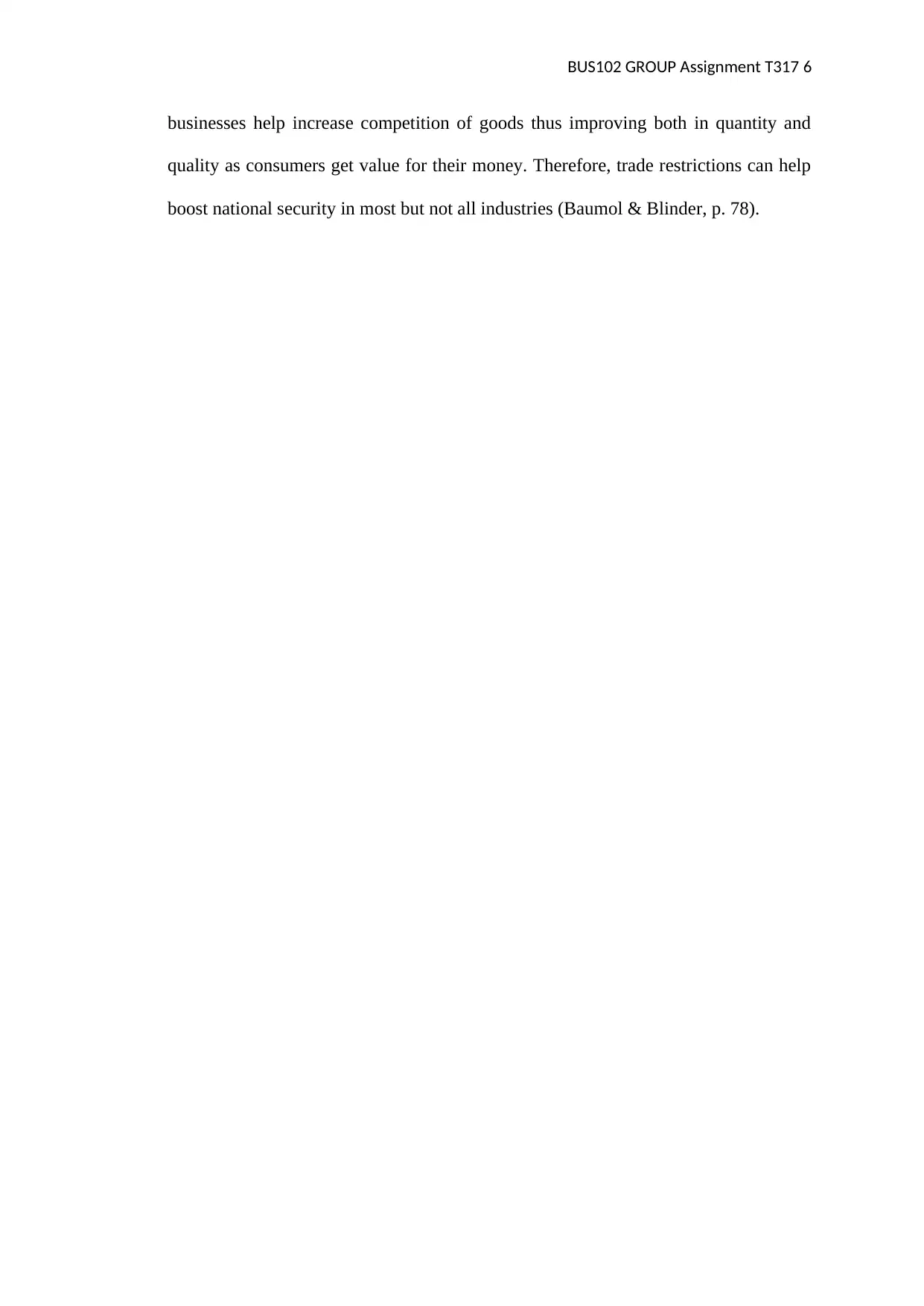
BUS102 GROUP Assignment T317 6
businesses help increase competition of goods thus improving both in quantity and
quality as consumers get value for their money. Therefore, trade restrictions can help
boost national security in most but not all industries (Baumol & Blinder, p. 78).
businesses help increase competition of goods thus improving both in quantity and
quality as consumers get value for their money. Therefore, trade restrictions can help
boost national security in most but not all industries (Baumol & Blinder, p. 78).
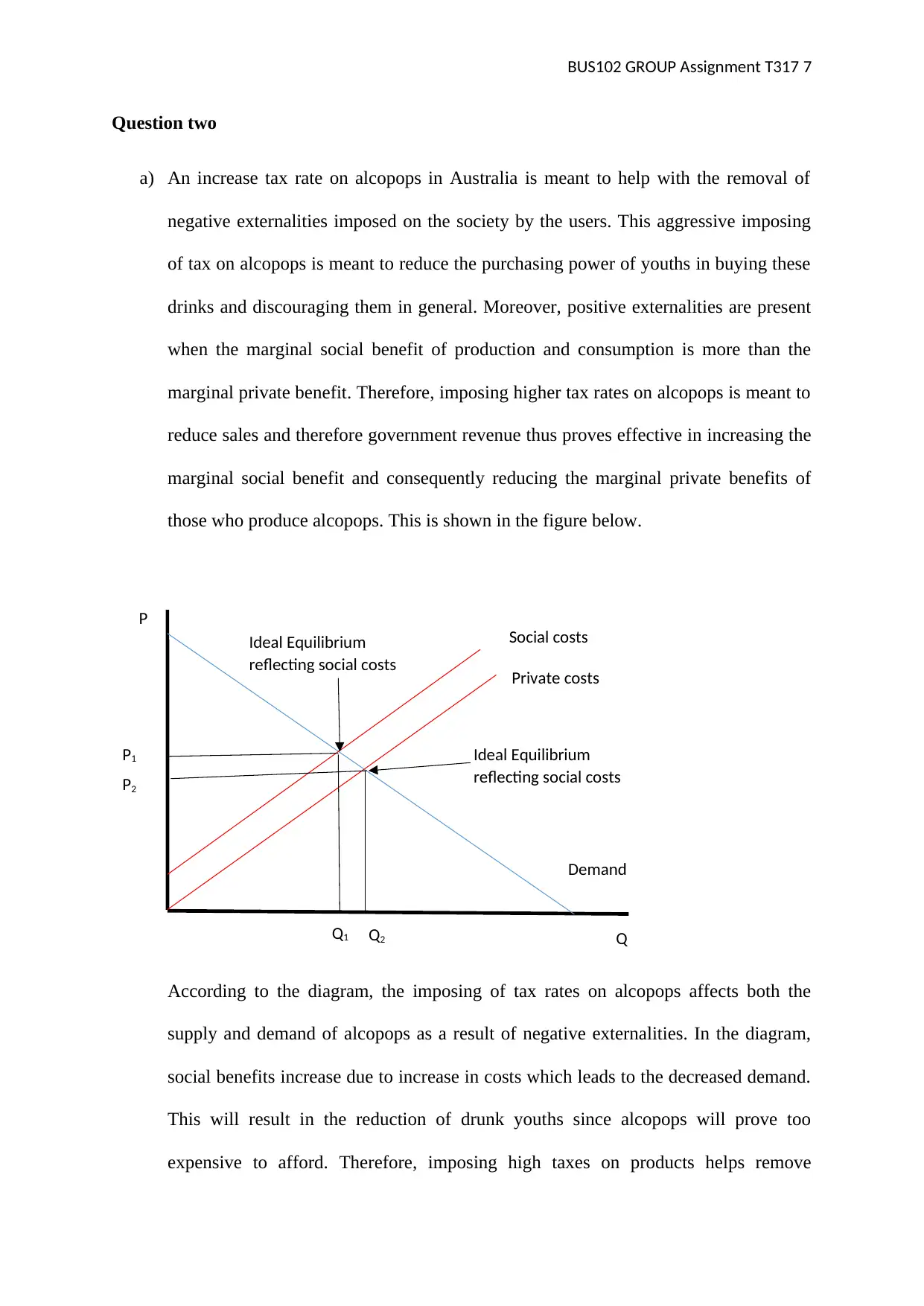
BUS102 GROUP Assignment T317 7
Question two
a) An increase tax rate on alcopops in Australia is meant to help with the removal of
negative externalities imposed on the society by the users. This aggressive imposing
of tax on alcopops is meant to reduce the purchasing power of youths in buying these
drinks and discouraging them in general. Moreover, positive externalities are present
when the marginal social benefit of production and consumption is more than the
marginal private benefit. Therefore, imposing higher tax rates on alcopops is meant to
reduce sales and therefore government revenue thus proves effective in increasing the
marginal social benefit and consequently reducing the marginal private benefits of
those who produce alcopops. This is shown in the figure below.
According to the diagram, the imposing of tax rates on alcopops affects both the
supply and demand of alcopops as a result of negative externalities. In the diagram,
social benefits increase due to increase in costs which leads to the decreased demand.
This will result in the reduction of drunk youths since alcopops will prove too
expensive to afford. Therefore, imposing high taxes on products helps remove
P
Ideal Equilibrium
reflecting social costs
Social costs
Q
Private costs
Ideal Equilibrium
reflecting social costs
Q1 Q2
P2
P1
Demand
Question two
a) An increase tax rate on alcopops in Australia is meant to help with the removal of
negative externalities imposed on the society by the users. This aggressive imposing
of tax on alcopops is meant to reduce the purchasing power of youths in buying these
drinks and discouraging them in general. Moreover, positive externalities are present
when the marginal social benefit of production and consumption is more than the
marginal private benefit. Therefore, imposing higher tax rates on alcopops is meant to
reduce sales and therefore government revenue thus proves effective in increasing the
marginal social benefit and consequently reducing the marginal private benefits of
those who produce alcopops. This is shown in the figure below.
According to the diagram, the imposing of tax rates on alcopops affects both the
supply and demand of alcopops as a result of negative externalities. In the diagram,
social benefits increase due to increase in costs which leads to the decreased demand.
This will result in the reduction of drunk youths since alcopops will prove too
expensive to afford. Therefore, imposing high taxes on products helps remove
P
Ideal Equilibrium
reflecting social costs
Social costs
Q
Private costs
Ideal Equilibrium
reflecting social costs
Q1 Q2
P2
P1
Demand
Paraphrase This Document
Need a fresh take? Get an instant paraphrase of this document with our AI Paraphraser
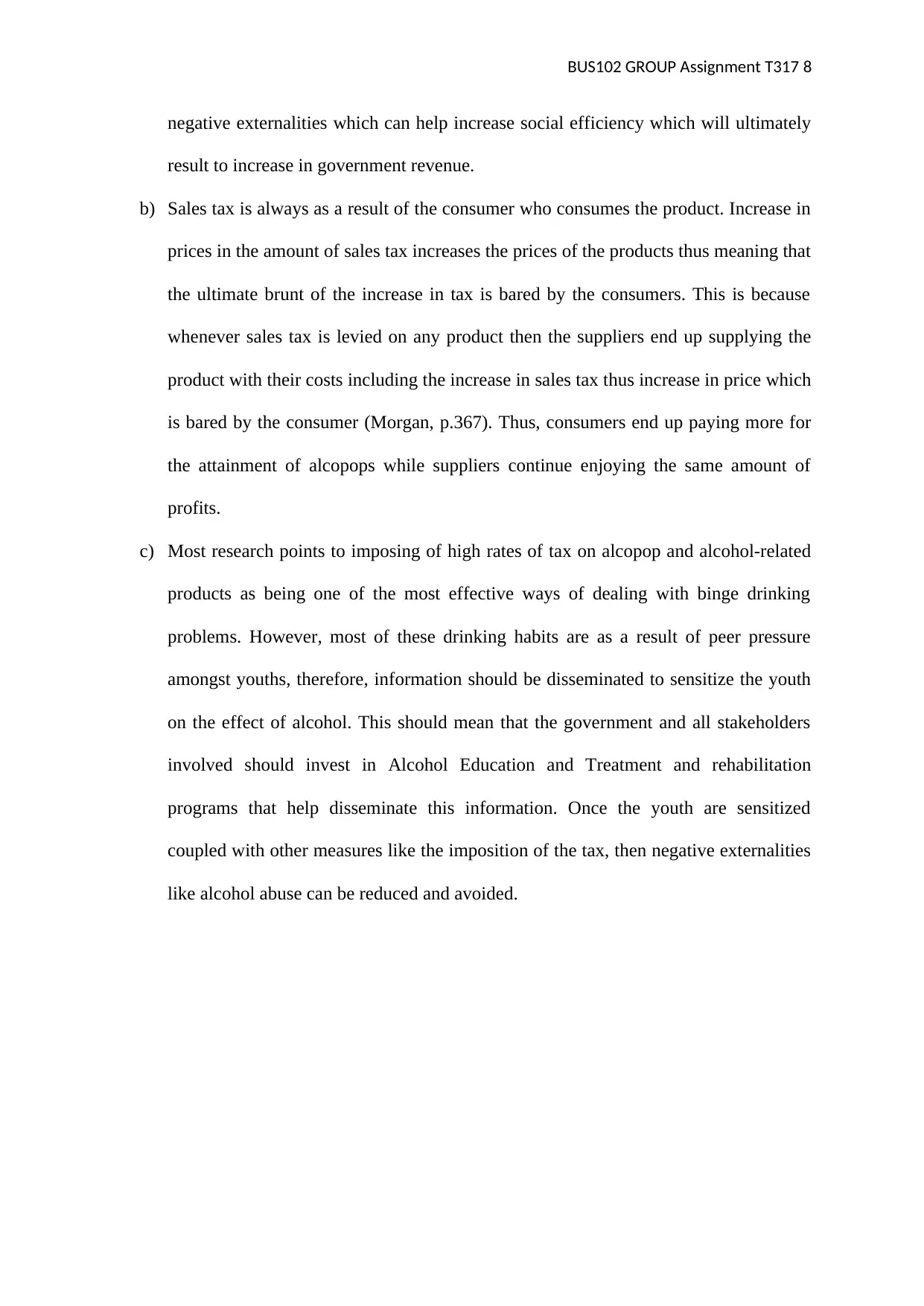
BUS102 GROUP Assignment T317 8
negative externalities which can help increase social efficiency which will ultimately
result to increase in government revenue.
b) Sales tax is always as a result of the consumer who consumes the product. Increase in
prices in the amount of sales tax increases the prices of the products thus meaning that
the ultimate brunt of the increase in tax is bared by the consumers. This is because
whenever sales tax is levied on any product then the suppliers end up supplying the
product with their costs including the increase in sales tax thus increase in price which
is bared by the consumer (Morgan, p.367). Thus, consumers end up paying more for
the attainment of alcopops while suppliers continue enjoying the same amount of
profits.
c) Most research points to imposing of high rates of tax on alcopop and alcohol-related
products as being one of the most effective ways of dealing with binge drinking
problems. However, most of these drinking habits are as a result of peer pressure
amongst youths, therefore, information should be disseminated to sensitize the youth
on the effect of alcohol. This should mean that the government and all stakeholders
involved should invest in Alcohol Education and Treatment and rehabilitation
programs that help disseminate this information. Once the youth are sensitized
coupled with other measures like the imposition of the tax, then negative externalities
like alcohol abuse can be reduced and avoided.
negative externalities which can help increase social efficiency which will ultimately
result to increase in government revenue.
b) Sales tax is always as a result of the consumer who consumes the product. Increase in
prices in the amount of sales tax increases the prices of the products thus meaning that
the ultimate brunt of the increase in tax is bared by the consumers. This is because
whenever sales tax is levied on any product then the suppliers end up supplying the
product with their costs including the increase in sales tax thus increase in price which
is bared by the consumer (Morgan, p.367). Thus, consumers end up paying more for
the attainment of alcopops while suppliers continue enjoying the same amount of
profits.
c) Most research points to imposing of high rates of tax on alcopop and alcohol-related
products as being one of the most effective ways of dealing with binge drinking
problems. However, most of these drinking habits are as a result of peer pressure
amongst youths, therefore, information should be disseminated to sensitize the youth
on the effect of alcohol. This should mean that the government and all stakeholders
involved should invest in Alcohol Education and Treatment and rehabilitation
programs that help disseminate this information. Once the youth are sensitized
coupled with other measures like the imposition of the tax, then negative externalities
like alcohol abuse can be reduced and avoided.
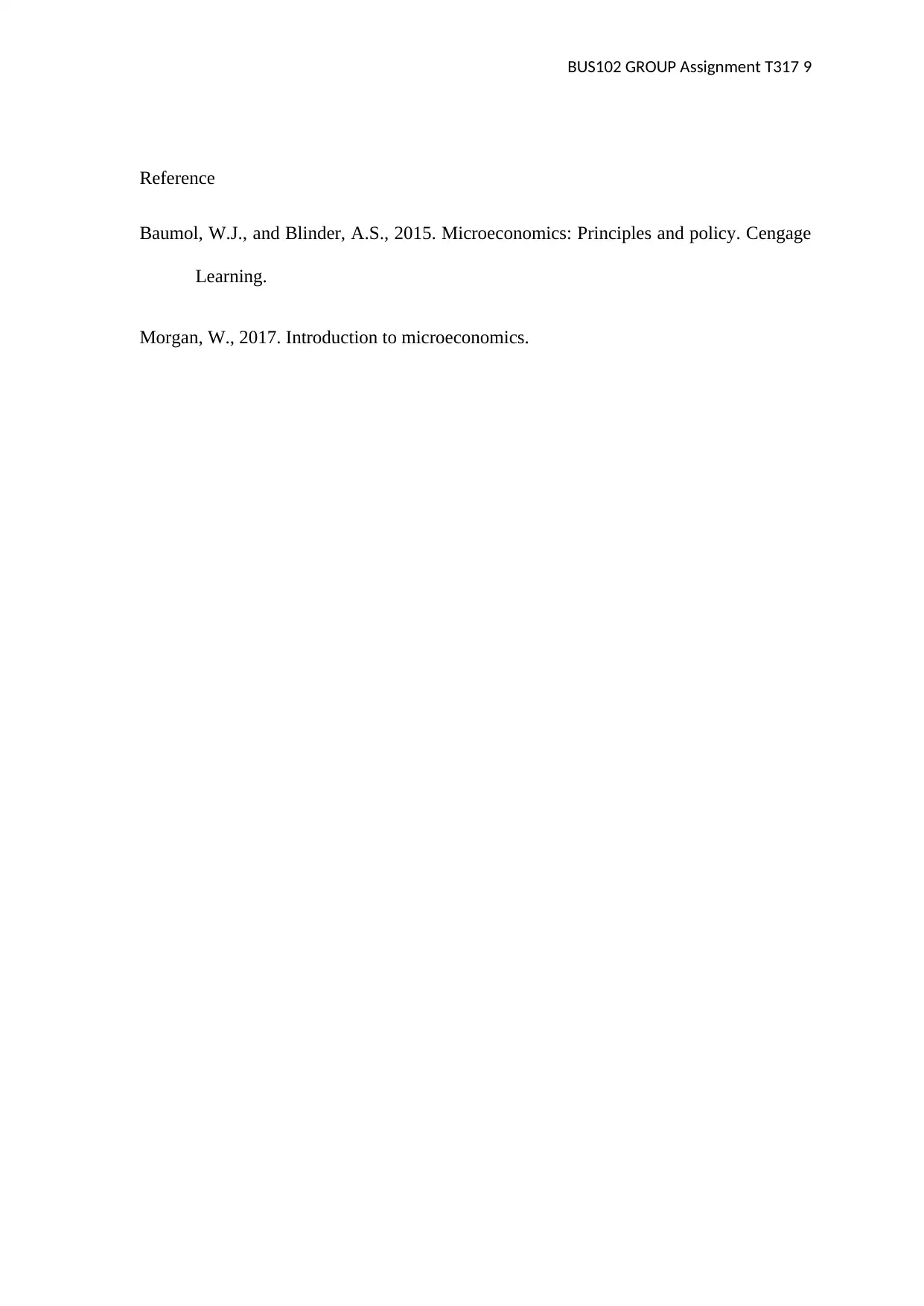
BUS102 GROUP Assignment T317 9
Reference
Baumol, W.J., and Blinder, A.S., 2015. Microeconomics: Principles and policy. Cengage
Learning.
Morgan, W., 2017. Introduction to microeconomics.
Reference
Baumol, W.J., and Blinder, A.S., 2015. Microeconomics: Principles and policy. Cengage
Learning.
Morgan, W., 2017. Introduction to microeconomics.
1 out of 9
Related Documents
Your All-in-One AI-Powered Toolkit for Academic Success.
+13062052269
info@desklib.com
Available 24*7 on WhatsApp / Email
![[object Object]](/_next/static/media/star-bottom.7253800d.svg)
Unlock your academic potential
© 2024 | Zucol Services PVT LTD | All rights reserved.





